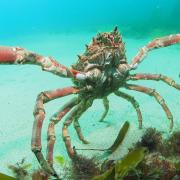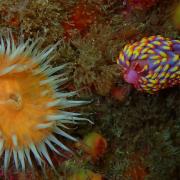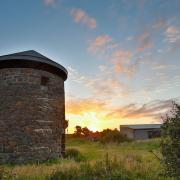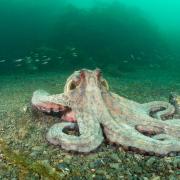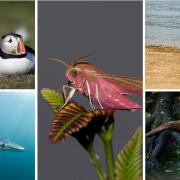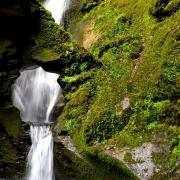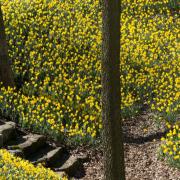The winter is a great time to see waders in Cornwall, and David Chapman discovers that his next door neighbour, artist Mike Wood, shares his enthusiasm for this breed
The winter is a great time to see waders in Cornwall, and David Chapman discovers that his next door neighbour, artist Mike Wood, shares his enthusiasm for this breed
When I first moved to Cornwall, about 18 years ago, I came to teach at Helston School. Within a couple of years I had married my wife, Sarah, and bought a smallholding near Hayle. I was a keen birdwatcher and enjoyed photographing birds, whenever I could get the time between marking books and planning lessons. I had a secret aspiration to become a professional wildlife photographer but didn’t dare to dream that on day it would come true.
What did surprise Sarah and I was that our new neighbour, Mike Wood, shared many of my interests. In his workshop he had back copies of all the birding magazines that I had managed to persuade Sarah to allow me to keep when we moved to our new house. His library of books bore more than a passing resemblance to my own but was more extensive. His interest in birds is more focussed than your average birdwatcher because Mike makes a living from carving birds.
I thought being a professional bird photographer was going to be a challenge but there are far fewer professional bird carvers than bird photographers, so Mike was to serve as an inspiration to me in my quest to turn professional. Mike really is at the top of his tree when it comes to carving. He regularly exhibits at bird-carving shows around the country and regularly wins awards for his work. His birds are so lifelike I could have been tempted to pass off a photo of one of his birds as a real one!One of the groups of birds he carves most frequently is the wader family. There are two species of godwit visiting Cornwall each year, the bar-tailed and the black-tailed, and they can be identified by the patterning on their tails.
Mike’s birds are so lifelike I could have been tempted to pass off a photo of one of his birds as a real one
We don’t often get to see them in their brick-red summer plumage because they don’t breed in Cornwall, rather just visit in the winter for the milder climate. In fact, bar-tailed godwits don’t even breed in Britain, though there are a few pairs of black-tailed godwits breeding in Somerset, Lancashire, Yorkshire and East Anglia.
One thing that always fascinates me about wading birds is the evolution of their beaks. Look at the godwits and you will see that their beaks are very long and almost straight, though the beak of the bar-tailed godwit is slightly up-turned and is quite flexible. They are designed to probe deep into the mud to find lugworms and have a sensitive tip designed to help them feel for movement.
The oystercatcher also has a long straight beak and is probably more familiar to most people. Oystercatchers are found in Cornwall throughout the year and can be seen on beaches, rocks and estuaries, and even on roundabouts and road verges beside the A30 near Penzance when the tide is high! They are noisy; their piping calls often drawing attention with striking black and white plumage and a bright orange bill.
Interestingly, the bills of oystercatchers have evolved in two different ways. Oystercatchers living in areas where cockles or mussels are the most abundant supply of food will grow a stouter bill, which they use to attack the muscle at the back of the cockle’s shell. Where lugworms are the main prey, oystercatchers have a slightly finer bill with which they probe the mud in a similar fashion to godwits.
Another wading bird with a wonderful bill is the avocet. It was once a common breeding bird in Britain but it ceased breeding in the middle of the 19th century, the last pair being recorded in Kent. When the marshes of East Anglia were flooded, as a form of defence during the Second World War, the avocet was attracted back again. The Royal Society for the Protection of Birds (RSPB) selected it as its emblem because of the avocet’s success in breeding at Minsmere, a reserve owned by the RSPB in Suffolk.
One thing that always fascinates me about wading birds is the evolution of their beaks
Due to increased awareness and more wildlife-friendly management of wetland reserves on the east coast, the avocet has now increased its range significantly. You may be wondering how this affects wildlife-watchers in Cornwall? As with most waders, the avocet flies south and west for winter to avoid the cold weather. Significant and increasing numbers have been recorded on the Tamar estuary since 1960 and this is now one of the most important sites in England for the avocet in winter. Cruises along the River Tamar are organised specifically to watch this delightful wader.
The avocet is black and white and is a relatively large wader but, unlike the oystercatcher, it is slim and long legged. Its ridiculously upturned bill could look incongruous but because it is so slender it somehow befits the rest of the bird. The avocet’s feeding movements have evolved to suit the shape of its bill (or vice versa). In this way the avocet collects creatures from the water’s surface, the shape of its beak enabling the bird to keep its head above water whilst having a good proportion of its beak just below the surface.
Where to go
If you want to see wading birds then you will have to go to an estuary or coastal location. The best places are the estuaries of the Hayle, Camel and Tamar. For avocets it has to be the Tamar, and the boat trips are the best way of seeing them, though a trip to Cargreen might be fruitful. I find the creeks along the River Fal are great for black-tailed godwits, with bar-tailed godwits seen on more open sandy areas such as the Hayle estuary or the Camel estuary near Padstow. Oystercatchers can be encountered on any stretch of coastline.
Learning More
Many of Mike’s wading birds are stocked at the Waterside Gallery in St Mawes. To learn more about Mike and to see examples of his work visit www.mikewoodbird.co.uk
For details about the Tamar birdwatching cruises, to see avocets and other birds with the guidance of experts, call Tamar Cruising on 01752 822105 or visit www.tamarcruising.com









